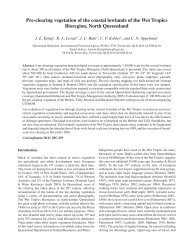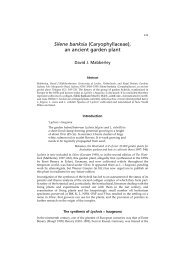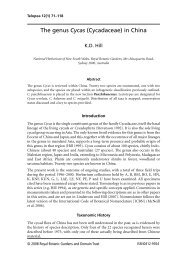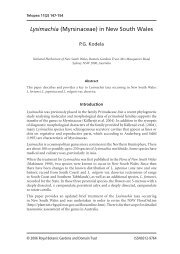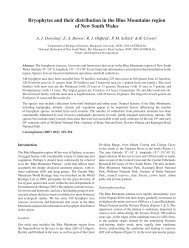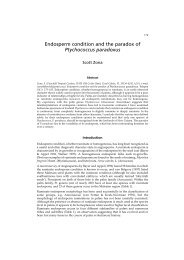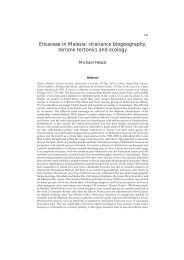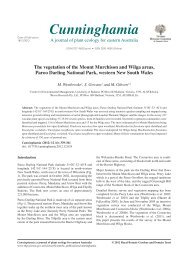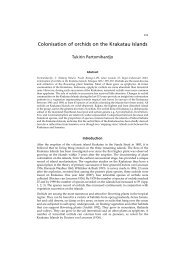The Eucalypts of the Greater Blue Mountains World Heritage Area ...
The Eucalypts of the Greater Blue Mountains World Heritage Area ...
The Eucalypts of the Greater Blue Mountains World Heritage Area ...
Create successful ePaper yourself
Turn your PDF publications into a flip-book with our unique Google optimized e-Paper software.
Cunninghamia 11(4): 2010 Hager & Benson, <strong>Eucalypts</strong> <strong>of</strong> <strong>the</strong> <strong>Greater</strong> <strong>Blue</strong> <strong>Mountains</strong> <strong>World</strong> <strong>Heritage</strong> <strong>Area</strong> 441<br />
Through <strong>the</strong> processes <strong>of</strong> wea<strong>the</strong>ring, rock breaks down into<br />
soil – some rocks create more fertile, higher nutrient soils<br />
than o<strong>the</strong>rs. <strong>The</strong> sandstones break down into low nutrient soils<br />
which hold little moisture. <strong>The</strong>re are many eucalypts typical<br />
<strong>of</strong> low nutrient sandstones including Angophora bakeri,<br />
Angophora hispida, Corymbia gummifera, and many <strong>of</strong> <strong>the</strong><br />
subgenus Eucalyptus such as <strong>the</strong> Eucalyptus–Green-leaved<br />
ashes and Eucalyptus <strong>Blue</strong>-leaved ashes B. <strong>The</strong> quartzites<br />
typical <strong>of</strong> <strong>the</strong> rugged valley <strong>of</strong> <strong>the</strong> mid Coxs River produce<br />
low nutrient soils, where Eucalyptus sieberi and Eucalyptus<br />
punctata commonly occur. <strong>The</strong> Permian coal measures,<br />
shale and volcanic rocks such as basalt and porphyry form a<br />
brown, loamy soil which is high in nutrients and retains more<br />
moisture. Distinctively different plant communities occur on<br />
<strong>the</strong>se soils, dominated by tall eucalypts such as Eucalyptus<br />
deanei, Eucalyptus fastigata or Eucalyptus muelleriana.<br />
Localised areas <strong>of</strong> basalt may have Eucalyptus saligna or<br />
Eucalyptus viminalis in higher rainfall areas or Eucalyptus<br />
albens and Eucalyptus moluccana in drier areas. Rainforests<br />
are largely restricted to <strong>the</strong> higher nutrient soils in <strong>the</strong> highest<br />
rainfall areas.<br />
Drainage<br />
<strong>The</strong> <strong>of</strong>ten steep topography in <strong>the</strong> sandstone areas generally<br />
allows water to run <strong>of</strong>f rapidly but where <strong>the</strong>re are layers <strong>of</strong><br />
impervious rock, such as claystone or ironstone, waterlogged<br />
conditions may occur allowing swamp communities to<br />
develop. Most eucalypt species are sensitive to waterlogged<br />
conditions and <strong>the</strong>y rarely occur in poorly-drained sites. An<br />
exception is Eucalyptus camphora found in swamps in <strong>the</strong><br />
Rylstone area. Species in alluvial habitats may recruit in<br />
temporarily wet sites after floods e.g. Eucalyptus benthamii,<br />
Eucalyptus elata.<br />
Aspect<br />
<strong>The</strong> aspect <strong>of</strong> <strong>the</strong> slope determines how much sunlight it gets,<br />
and which winds it is more exposed to. In general, northfacing<br />
slopes are drier and hotter, supporting a different<br />
suite <strong>of</strong> smaller eucalypts than south-facing slopes. Exposed<br />
sites associated with cliff-lines in <strong>the</strong> upper mountains may<br />
frequently have <strong>the</strong> mallees e.g. Eucalyptus cunninghamii,<br />
Eucalyptus stricta, though <strong>the</strong>se sites are also influenced by<br />
drainage and slope characteristics.<br />
Fig. 4. Mountain Gum forest in Kanangra-Boyd National Park. Large shaggy trunks <strong>of</strong> Eucalyptus dalrympleana with smaller trees <strong>of</strong><br />
Eucalyptus pauciflora, Snow Gum, in background.




